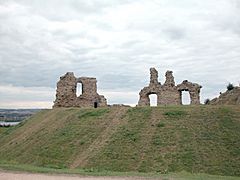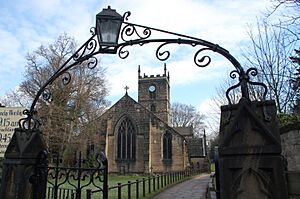Sandal Magna facts for kids
Quick facts for kids Sandal |
|
|---|---|
 Sandal Castle remains |
|
| Population | 5,432 |
| OS grid reference | SE340180 |
| Metropolitan borough | |
| Metropolitan county | |
| Region | |
| Country | England |
| Sovereign state | United Kingdom |
| Post town | WAKEFIELD |
| Postcode district | WF2 |
| Dialling code | 01924 |
| Police | West Yorkshire |
| Fire | West Yorkshire |
| Ambulance | Yorkshire |
| EU Parliament | Yorkshire and the Humber |
| UK Parliament |
|
Sandal is a lively area in Wakefield, West Yorkshire, England. It's home to about 5,400 people. This old place is famous for Sandal Castle and is even mentioned in a very old book called the Domesday Book. Sandal is about 2 miles (3.2 km) south of Wakefield and 8 miles (13 km) north of Barnsley.
A big battle called the Battle of Wakefield happened here in the 1400s. This battle was part of the Wars of the Roses, a series of fights for the English throne.
Contents
Sandal's Story: A Look Back in Time
What's in a Name?
The name Sandal comes from old Scandinavian words. Sandr meant sand or gravel, and healh meant a meadow. So, Sandal likely means a "sandy meadow."
Early Days of Sandal
In the year 1086, the Domesday Book mentioned Sandal. It was described as a berewic, which was a village where barley was grown. There was also a church with a priest in Sandal, located where St Helen's Church stands today.
Around 1107, a powerful person named William de Warenne, 2nd Earl of Surrey was given the lands of Sandal. He started building Sandal Castle, which became a very important home for the lords of the Wakefield area.
The Battle of Wakefield
A major historical event took place here during the Wars of the Roses. On December 30, 1460, the Duke of York was killed in the Battle of Wakefield. This battle happened between Sandal Castle and St Helen's Church.
People in Sandal were also busy with mining for coal and digging for stone as early as the 1300s.
A Famous Highwayman
Later, in 1684, a well-known highwayman named John Nevison was caught at the Three Houses Inn in Sandal. He was arrested for the murder of a constable named Darcy Fletcher.
Where is Sandal?
Sandal is located south of the River Calder. It sits on the main road that goes from Wakefield to Barnsley. The area covers about 1,700 acres (6.9 km²).
It's about 2 miles (3.2 km) from Wakefield and 8 miles (13 km) from Barnsley. Other nearby towns include Pontefract (9 miles or 14 km), Leeds (15 miles or 24 km), and Sheffield (25 miles or 40 km). The main road running through Sandal is the A61.
 |
Ossett | Wakefield | Normanton |  |
| Horbury | Crofton | |||
| West Bretton | Barnsley | Ryhill |
How Sandal Was Governed
Sandal was once an old parish town in a division called Agbrigg. This area was part of the West Riding of Yorkshire.
Religious Life in Sandal
Sandal Magna's main church is named after St. Helen, who was the mother of Constantine the Great. When the Normans conquered England, Sandal Church belonged to the crown. The original Saxon church was mentioned in the Domesday Book in 1086.
Around 1150, the first church was replaced by a second one, built in the shape of a Latin cross. This was done by Earl Warenne from Sandal Castle. The church was made bigger around 1180 and then almost completely rebuilt in the early 1300s. After 1505, more changes and additions were made. The church we see today was greatly repaired and made larger in 1872.
Getting Around Sandal
The Sandal and Agbrigg railway station is on the Wakefield line. Trains here are run by Northern. This station serves both Sandal and the nearby area of Agbrigg.
Things to Do in Sandal
Sandal is mostly a place where people live. It has many useful things for residents, including a library and several schools. There's also the Anglican church of St Helen and a Methodist church. For shopping, there's an Asda supermarket.



